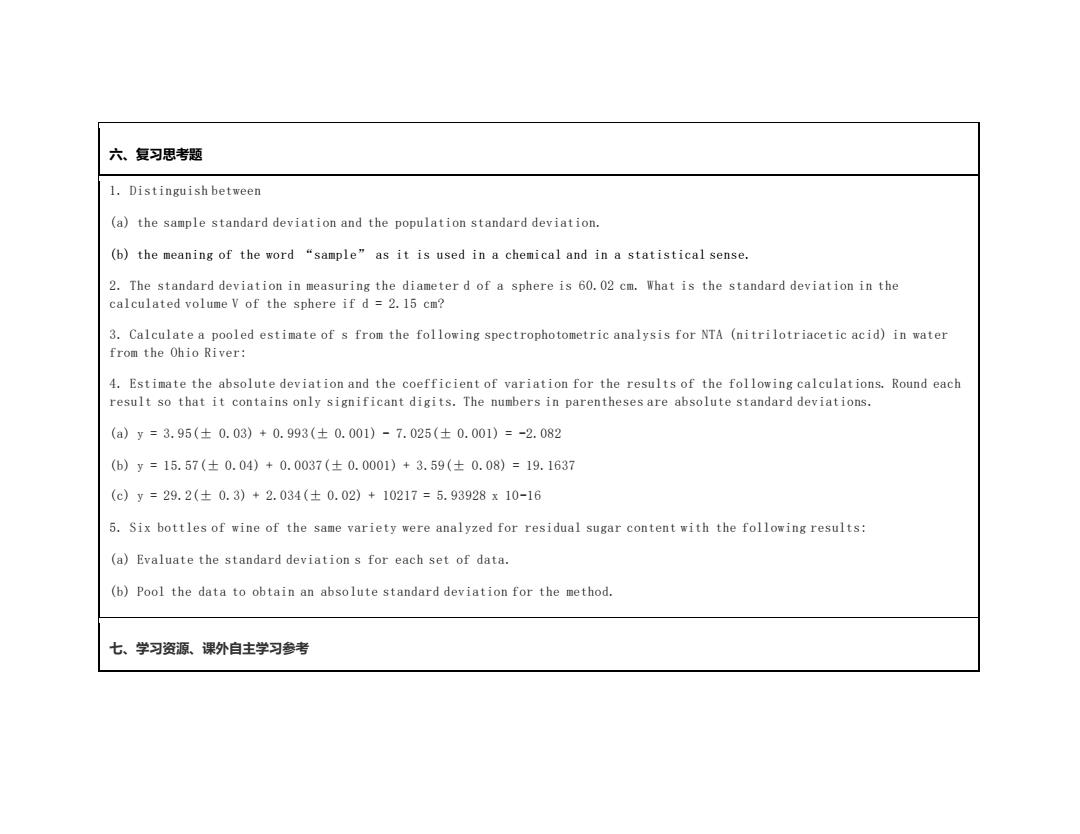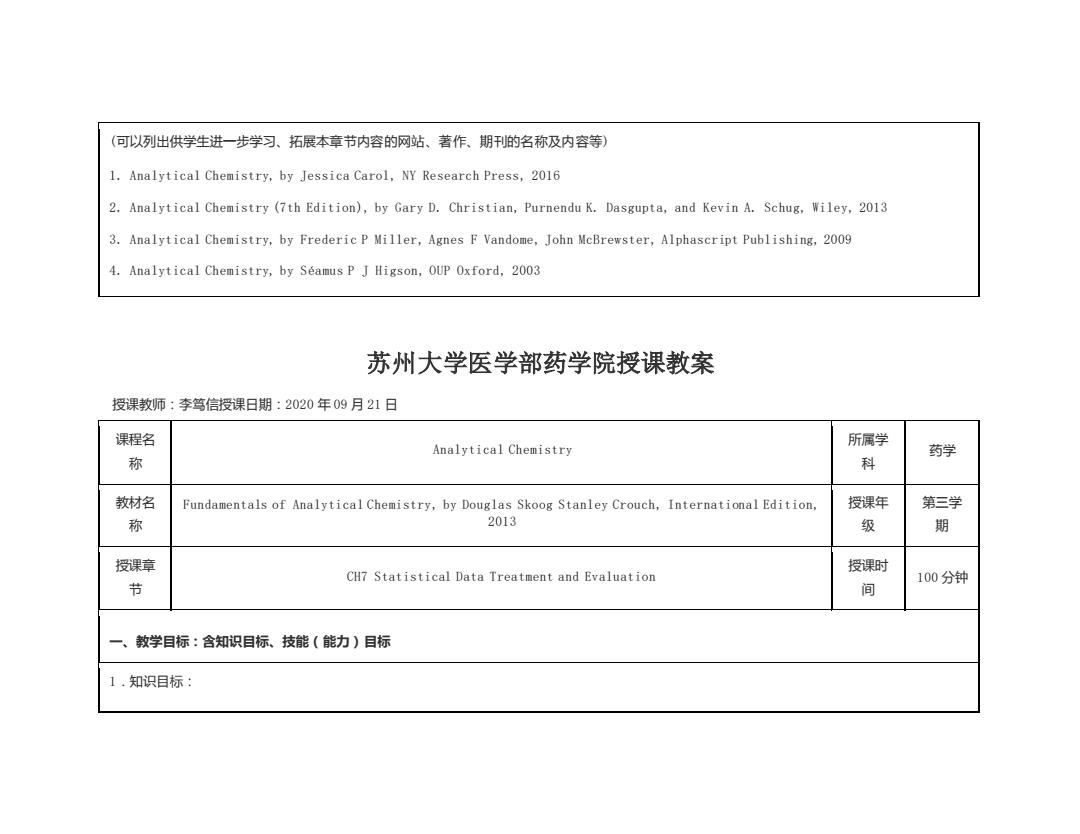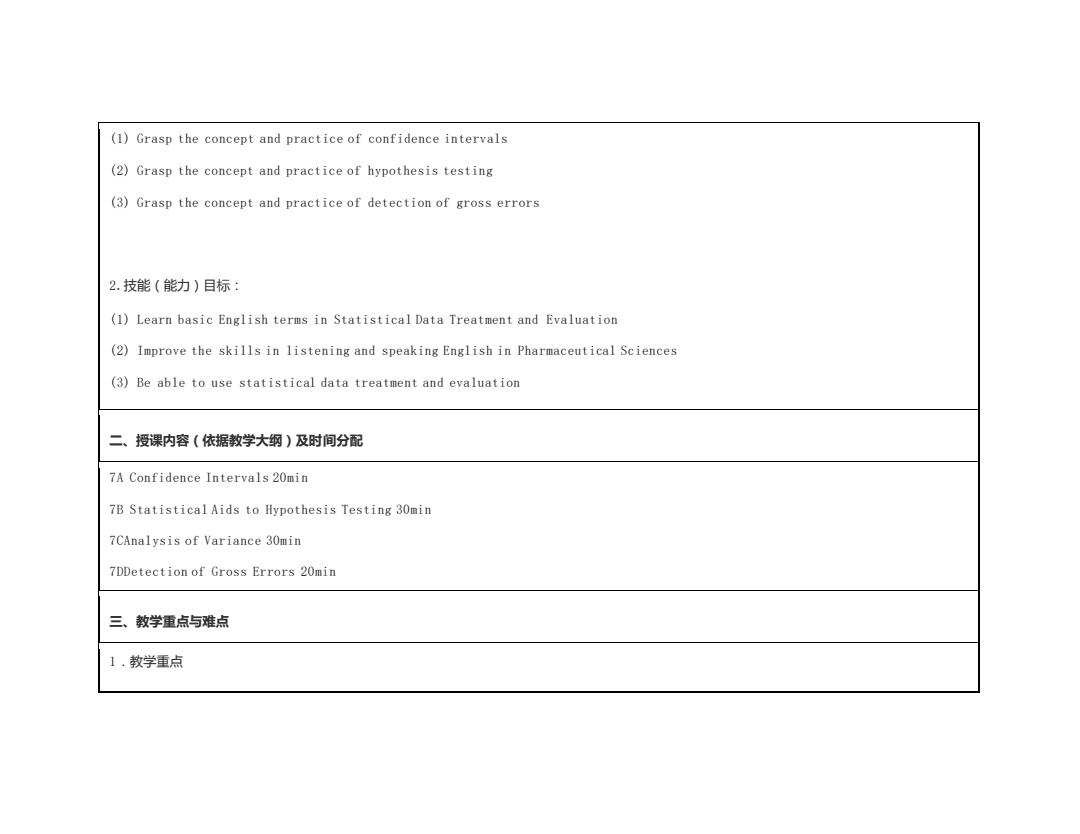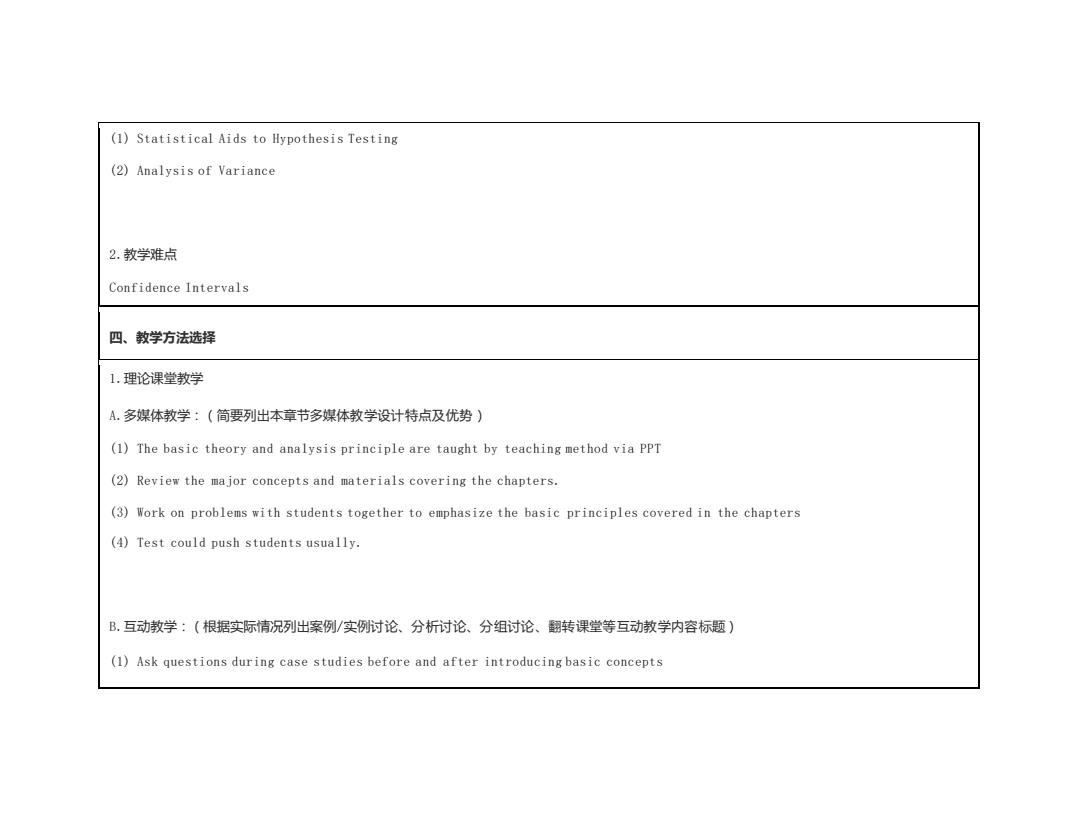
六、复习思考题 1.Distinguish between (a)the sample standard deviation and the population standard deviation. (b)the meaning of the word "sample"as it is used in a chemical and in a statistical sense. 2.The standard deviation in measuring the diameter d of a sphere is 60.02 cm.What is the standard deviation in the calculated volume V of the sphere if d =2.15 cm? 3.Calculate a pooled estimate of s from the following spectrophotometric analysis for NTA (nitrilotriacetic acid)in water from the Ohio River: 4.Estimate the absolute deviation and the coefficient of variation for the results of the following calculations.Round each result so that it contains only significant digits.The numbers in parentheses are absolute standard deviations. (a)y=3.95(±0.03)+0.993(±0.001)-7.025(±0.001)=-2.082 (b)y=15.57(±0.04)+0.0037(±0.0001)+3.59(±0.08)=19.1637 (c)y=29.2(±0.3)+2.034(±0.02)+10217=5.93928x10-16 5.Six bottles of wine of the same variety were analyzed for residual sugar content with the following results: (a)Evaluate the standard deviation s for each set of data. (b)Pool the data to obtain an absolute standard deviation for the method. 七、学习资源、课外自主学习参考
六、复习思考题 1. Distinguish between (a) the sample standard deviation and the population standard deviation. (b) the meaning of the word “sample” as it is used in a chemical and in a statistical sense. 2. The standard deviation in measuring the diameter d of a sphere is 60.02 cm. What is the standard deviation in the calculated volume V of the sphere if d = 2.15 cm? 3. Calculate a pooled estimate of s from the following spectrophotometric analysis for NTA (nitrilotriacetic acid) in water from the Ohio River: 4. Estimate the absolute deviation and the coefficient of variation for the results of the following calculations. Round each result so that it contains only significant digits. The numbers in parentheses are absolute standard deviations. (a) y = 3.95(± 0.03) + 0.993(± 0.001) - 7.025(± 0.001) = -2.082 (b) y = 15.57(± 0.04) + 0.0037(± 0.0001) + 3.59(± 0.08) = 19.1637 (c) y = 29.2(± 0.3) + 2.034(± 0.02) + 10217 = 5.93928 x 10-16 5. Six bottles of wine of the same variety were analyzed for residual sugar content with the following results: (a) Evaluate the standard deviation s for each set of data. (b) Pool the data to obtain an absolute standard deviation for the method. 七、学习资源、课外自主学习参考

(可以列出供学生进一步学习、拓展本章节内容的网站、著作、期刊的名称及内容等) 1.Analytical Chemistry,by Jessica Carol,NY Research Press,2016 2.Analytical Chemistry (7th Edition),by Gary D.Christian,Purnendu K.Dasgupta,and Kevin A.Schug,Wiley,2013 3.Analytical Chemistry,by Frederic P Miller,Agnes F Vandome,John McBrewster,Alphascript Publishing,2009 4.Analytical Chemistry,by Seamus P J Higson,OUP Oxford,2003 苏州大学医学部药学院授课教案 授课教师:李笃信授课日期:2020年09月21日 课程名 所属学 Analytical Chemistry 药学 称 科 教材名 Fundamentals of Analytical Chemistry,by Douglas Skoog Stanley Crouch,International Edition, 授课年 第三学 称 2013 级 期 授课章 授课时 CH7 Statistical Data Treatment and Evaluation 100分钟 节 间 一、教学目标:含知识目标、技能(能力)目标 1.知识目标:
(可以列出供学生进一步学习、拓展本章节内容的网站、著作、期刊的名称及内容等) 1. Analytical Chemistry, by Jessica Carol, NY Research Press, 2016 2. Analytical Chemistry (7th Edition), by Gary D. Christian, Purnendu K. Dasgupta, and Kevin A. Schug, Wiley, 2013 3. Analytical Chemistry, by Frederic P Miller, Agnes F Vandome, John McBrewster, Alphascript Publishing, 2009 4. Analytical Chemistry, by Séamus P J Higson, OUP Oxford, 2003 苏州大学医学部药学院授课教案 授课教师:李笃信授课日期:2020 年 09 月 21 日 课程名 称 Analytical Chemistry 所属学 科 药学 教材名 称 Fundamentals of Analytical Chemistry, by Douglas Skoog Stanley Crouch, International Edition, 2013 授课年 级 第三学 期 授课章 节 CH7 Statistical Data Treatment and Evaluation 授课时 间 100 分钟 一、教学目标:含知识目标、技能(能力)目标 1.知识目标:

(1)Grasp the concept and practice of confidence intervals (2)Grasp the concept and practice of hypothesis testing (3)Grasp the concept and practice of detection of gross errors 2.技能(能力)目标: (1)Learn basic English terms in Statistical Data Treatment and Evaluation (2)Improve the skills in listening and speaking English in Pharmaceutical Sciences (3)Be able to use statistical data treatment and evaluation 二、授课内容(依据教学大纲)及时间分配 7A Confidence Intervals 20min 7B Statistical Aids to Hypothesis Testing 30min 7CAnalysis of Variance 30min 7DDetection of Gross Errors 20min 三、教学重点与难点 1.教学重点
(1) Grasp the concept and practice of confidence intervals (2) Grasp the concept and practice of hypothesis testing (3) Grasp the concept and practice of detection of gross errors 2.技能(能力)目标: (1) Learn basic English terms in Statistical Data Treatment and Evaluation (2) Improve the skills in listening and speaking English in Pharmaceutical Sciences (3) Be able to use statistical data treatment and evaluation 二、授课内容(依据教学大纲)及时间分配 7A Confidence Intervals 20min 7B Statistical Aids to Hypothesis Testing 30min 7CAnalysis of Variance 30min 7DDetection of Gross Errors 20min 三、教学重点与难点 1.教学重点

(1)Statistical Aids to Hypothesis Testing (2)Analysis of Variance 2.教学难点 Confidence Intervals 四、教学方法选择 1.理论课堂教学 A.多媒体教学:(简要列出本章节多媒体教学设计特点及优势) (1)The basic theory and analysis principle are taught by teaching method via PPT (2)Review the major concepts and materials covering the chapters. (3)Work on problems with students together to emphasize the basic principles covered in the chapters (4)Test could push students usually. B.互动教学:(根据实际情况列出案例/实例时论、分析讨论、分组讨论、翻转课堂等互动教学内容标题) (1)Ask questions during case studies before and after introducing basic concepts
(1) Statistical Aids to Hypothesis Testing (2) Analysis of Variance 2.教学难点 Confidence Intervals 四、教学方法选择 1.理论课堂教学 A.多媒体教学:(简要列出本章节多媒体教学设计特点及优势) (1) The basic theory and analysis principle are taught by teaching method via PPT (2) Review the major concepts and materials covering the chapters. (3) Work on problems with students together to emphasize the basic principles covered in the chapters (4) Test could push students usually. B.互动教学:(根据实际情况列出案例/实例讨论、分析讨论、分组讨论、翻转课堂等互动教学内容标题) (1) Ask questions during case studies before and after introducing basic concepts

(2)Discuss the complicated concepts (3)Solve problems together with students 2.实验课教学 No applicable. 五、更新或补充内容提要 课后总结:按照实际进度对知识点分详略进行讲解 Emphasize the key concept and adjust the amount of materials in each section 六、复习思考题 1.Describe in your own words why the confidence interval for the mean of five measurements is smaller than that for a single result. 2.Discuss how the size of the confidence interval for the mean is influenced by the following (all the other factors are constant): (a)the standard deviation s. (b)the sample size N. (c)the confidence level
(2) Discuss the complicated concepts (3) Solve problems together with students 2.实验课教学 No applicable. 五、更新或补充内容提要 课后总结:按照实际进度对知识点分详略进行讲解 Emphasize the key concept and adjust the amount of materials in each section 六、复习思考题 1. Describe in your own words why the confidence interval for the mean of five measurements is smaller than that for a single result. 2. Discuss how the size of the confidence interval for the mean is influenced by the following (all the other factors are constant): (a) the standard deviation s. (b) the sample size N. (c) the confidence level